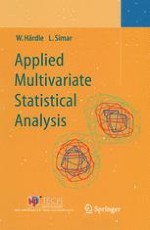2003 | OriginalPaper | Buchkapitel
Discriminant Analysis
verfasst von : Wolfgang Härdle, Léopold Simar
Erschienen in: Applied Multivariate Statistical Analysis
Verlag: Springer Berlin Heidelberg
Enthalten in: Professional Book Archive
Aktivieren Sie unsere intelligente Suche, um passende Fachinhalte oder Patente zu finden.
Wählen Sie Textabschnitte aus um mit Künstlicher Intelligenz passenden Patente zu finden. powered by
Markieren Sie Textabschnitte, um KI-gestützt weitere passende Inhalte zu finden. powered by
Discriminant analysis is used in situations where the clusters are known a priori. The aim of discriminant analysis is to classify an observation, or several observations, into these known groups. For instance, in credit scoring, a bank knows from past experience that there are good customers (who repay their loan without any problems) and bad customers (who showed difficulties in repaying their loan). When a new customer asks for a loan, the bank has to decide whether or not to give the loan. The past records of the bank provides two data sets: multivariate observations xi on the two categories of customers (including for example age, salary, marital status, the amount of the loan, etc.). The new customer is a new observation x with the same variables. The discrimination rule has to classify the customer into one of the two existing groups and the discriminant analysis should evaluate the risk of a possible “bad decision”.
